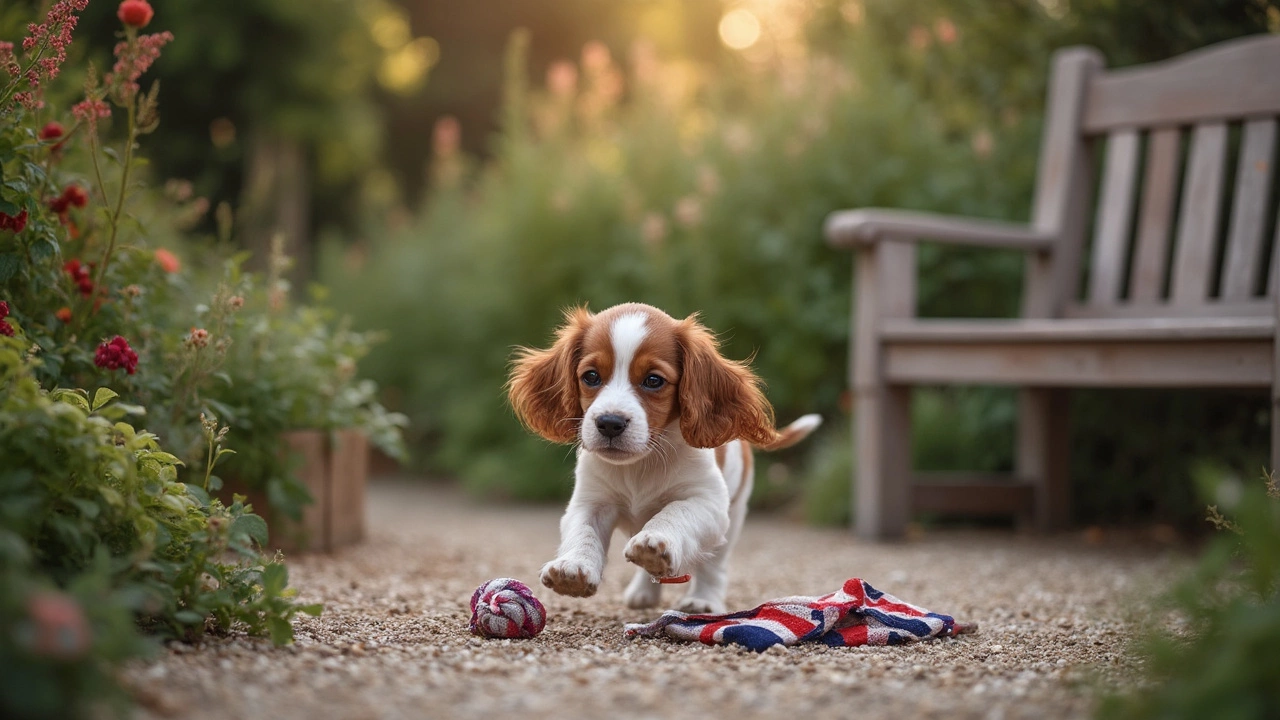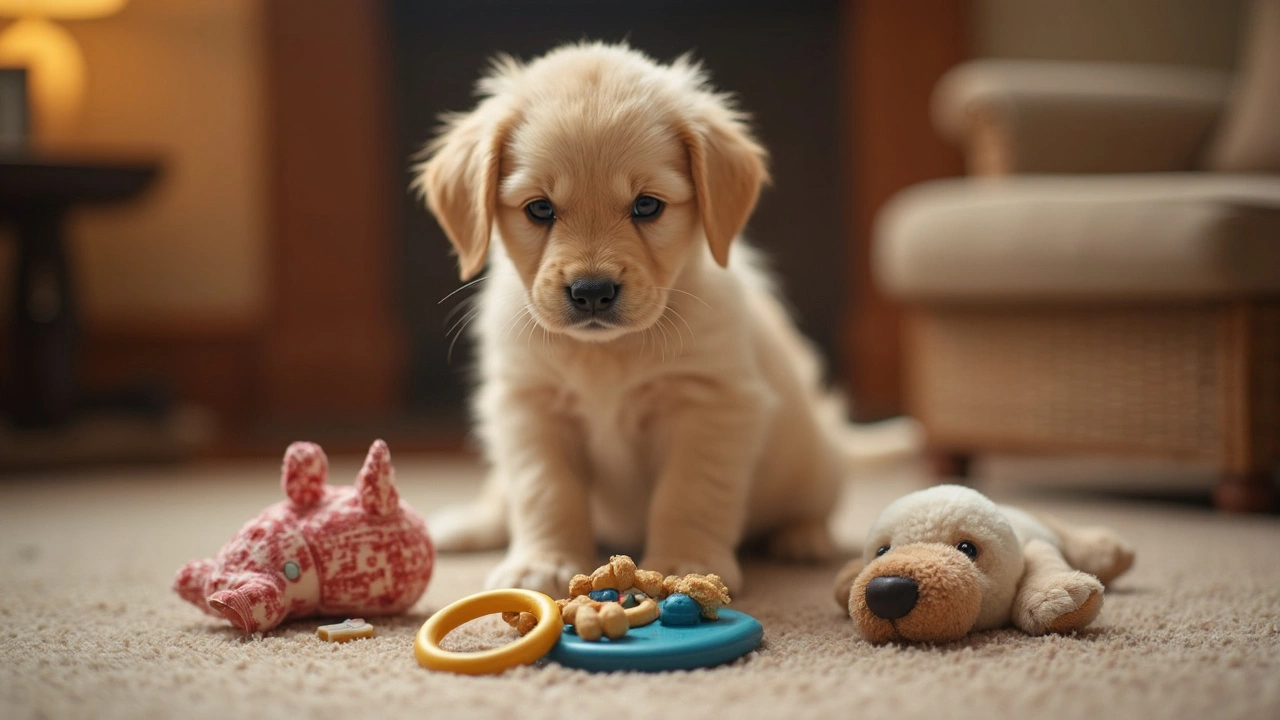Bringing a new puppy home is like having a whirlwind of fluff and energy. You’re excited, they’re excited — but where to start with toys? This is where the Rule of 3 steps in to make life a bit simpler. So, what is this rule anyway? It’s a guide to help you pick the perfect, safe toys for your little fur ball.
The gist is you want toys that do three things: keep those tiny teeth busy, provide mental challenges, and offer comfort when things get a bit overwhelming. Think of it as a balanced toy diet, but for their brain and body. Isn’t that neat?
You know how new puppies are like toddlers—they chew on anything that fits in their mouth. That’s why having a durable teething toy is a must. It saves your shoes and furniture while giving their growing teeth some much-needed exercise.
Next up is mental stimulation. Puppies aren’t just sleeping and eating machines; they need their brains tickled too. Brain games or puzzle toys can keep them sharp and reduce boredom-related mischief, like nibbling on your favorite socks!
- Understanding the Rule of 3
- Safety First: Choosing the Right Toys
- Balancing Playtime and Rest
- Engaging Activities for Puppy Growth
Understanding the Rule of 3
The Rule of 3 is like a playtime compass, pointing you in the right direction for your new puppy's needs. It’s all about picking the right mix of puppy toys that will keep your furry friend entertained, engaged, and stress-free. So why exactly do we call it the Rule of 3? Simple! It breaks down into three key types of toys every puppy should have.
First, let’s tackle teething toys. Your new pup's growing teeth need something safe to chew on. Imagine teethers for babies, but furrier. Chewing is natural and helps relieve discomfort, so these toys are just perfect for saving your shoes and furniture from those little jaws of fury!
Second, we have mental stimulation toys. These challenge your puppy’s brain, which is super important because a bored puppy can turn your home upside down. Think about puzzle feeders or tug toys that make them think and play at the same time.
Lastly, comfort toys are just like comfort blankets for kids. They're all about providing emotional support, especially during those first nights away from their litter mates. Having a soft, snuggly toy can ease those jitters and make your pup feel at home.
| Category | Purpose | Example |
|---|---|---|
| Teething Toys | Help with growing teeth and chewing | Rubber bones |
| Mental Stimulation Toys | Encourage brain activity and reduce boredom | Puzzle feeders |
| Comfort Toys | Provide emotional security | Plush animals |
With these three types of toys, you’re setting up a balanced 'toy diet' for your pup. Follow the Rule of 3 and you’ll have a happy, healthy, and well-adjusted new family member.
Safety First: Choosing the Right Toys
When it comes to picking out puppy toys, safety should always come first, no questions asked. Puppies are like curious little explorers; everything goes straight in their mouth. So, let's make sure their playthings are safe!
The first step is checking the size. Ever seen a puppy trying to swallow a toy like it’s the last kibble on Earth? A toy should never be small enough to swallow or get lodged in their throat. Opt for sizes that are bigger than their mouth and sturdy enough to withstand some gag-inducing chewing.
Material matters too. Avoid toys made of cheap plastic that can splinter. Go for durable rubber or fabric designed for new puppy teething. A torn toy can be a hazard, so inspect them regularly for wear and tear, tossing them as needed.
Here's great advice from Dr. Pete, a well-known vet, “With young puppies, aim for toys that can't be torn apart easily. Soft toys are fine, but watch out for fillings that could end up swallowed.”
“Always supervise play time with new toys. It takes a moment for fun to turn into an accident.” - Dr. Pete, Vet Expert
Look for multi-purpose toys. Think of toys that squeak, float, or come with treats inside. These are not just safe but also puzzling enough to keep your pup engaged.
- Choose toys made specifically for puppies—adult dog toys can be too tough.
- Skip the rawhide; it's notoriously unpredictable and can swell in the stomach.
- Consider toys with textured surfaces to help with teething discomfort.
Lastly, listen to your gut. If a toy seems iffy, just say no. It’s not worth the risk. As always, the right toy is the one you feel good about giving your pet while keeping their safety in mind.

Balancing Playtime and Rest
It’s tempting to let your new puppy play all day, but just like us, they need a balance of activity and downtime. Puppies can get overstimulated easily, and squeezing in some rest is crucial for their development. Let’s get into how you can manage this balance.
First off, puppy energy might seem endless, but it’s not. These little furballs need about 18-20 hours of sleep a day, especially when they are in their initial growth phases. So, it’s important to schedule play around frequent naps.
Here’s a simple routine to follow:
- Engage in a play session lasting 10-15 minutes; this keeps your puppy entertained without tiring them out too much.
- Follow up with some quiet time where they can rest in a cozy spot with a comfort toy.
- Repeat this cycle 4-5 times throughout the day, ensuring they’re not playing continuously for more than an hour without a break.
While toys are crucial during playtime, rest time is just as important. For optimal growth, their brains and bodies need time to decompress. Opt for a comfy bed or blanket where they can snuggle, and try to keep this rest spot consistent so they know this is their chill-out zone.
Did you know? Young puppies can burn out easily, sometimes without you even noticing. If they start whining, panting a lot, or seem to lose interest in play, they might be telling you they need a breather.
Remember, understanding your puppy's cues is key. As they grow, their play needs will change, and you'll become more attuned to how much energy they expend versus how much they recuperate. Mastering this balance can make you and your puppy a super-chilled team.
Engaging Activities for Puppy Growth
Alright, let's get into the fun stuff: activities that help your puppy grow mentally and physically. A new puppy is like a sponge, ready to absorb new experiences and skills. It's a time to mix play with learning, and trust me, both you and your puppy will enjoy it!
First up, let's talk about fetch. It’s a classic but for a reason—it's great for exercise and strengthens the bond between you and your fur pal. Start in a small fenced area to keep it safe and let your puppy get used to the concept.
Next, try simple obedience training. Teaching commands like 'sit,' 'stay,' and 'come' can be a fun game for them. Use treats as rewards, which makes it a playful activity rather than a strict lesson. It’s amazing how quickly puppies pick up on things when food is involved!
If you're up for a little DIY, obstacle courses are a blast. Use common household items like cushions, boxes, or makeshift tunnels to create a mini adventure park. Guide your puppy through the course, rewarding them with treats and praise along the way.
- Puppy play dates: Socialization is key. Set up dates with vaccinated puppy buddies to help your little one get comfortable around other dogs.
- Interactive toys: These are perfect for rainy days. Toys that dispense treats or can be stuffed with peanut butter (the kind without xylitol) keep them entertained and mentally stimulated.
- Puppy puzzles: Ever heard of treat puzzles? They're like Sudoku for dogs and challenge their problem-solving skills. Start with simpler puzzles and move to more complex ones as they get the hang of it.
Research even suggests that mentally stimulated puppies develop fewer behavioral issues as they grow. Keeping them both physically active and mentally engaged is crucial for balanced puppy growth. No one wants a bored puppy getting into mischief around the house!
